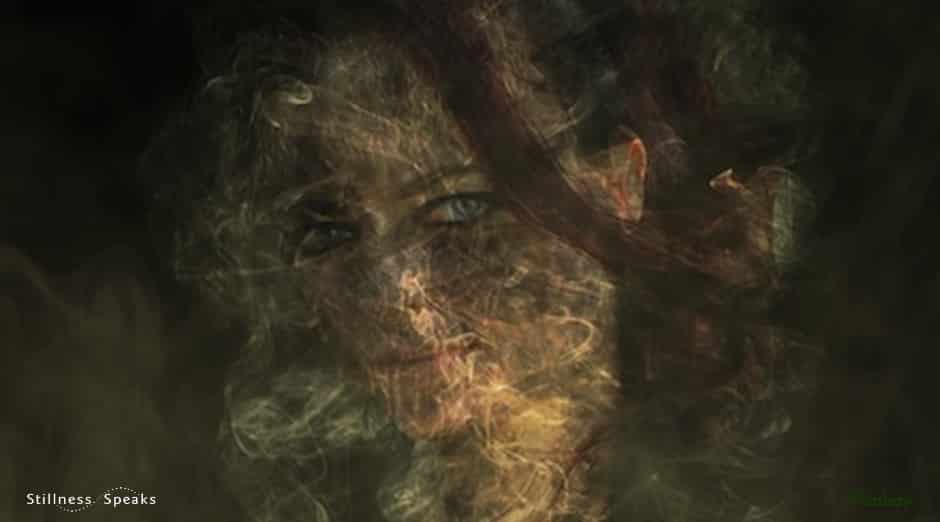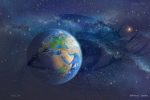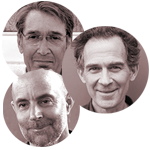Awareness can be experienced in two ways, awareness of being-ness (pure self) and awareness of nonbeing-ness (selfless awareness). Both are awareness, but it seems that awareness has two faces. ~ Hameed Ali
We are pleased to offer this fascinating and challenging conversation, recorded at the 2013 Science and Non-Duality (SAND) Conference, between Hameed Ali (A.H. Almaas) and Rupert Spira and moderated by Zaya Benazzo. This discussion focuses on the nature of awareness and perception, and challenges each teacher to clarify the way he describes awareness, perception and knowing. Their uses of language and definition appear, at times, to diverge. This overview previews the hour long video. All text in italics is taken directly from the video.
The talks opens with an inquiry: how can we reconcile the two contrasting notions of experience — the tangible and the illusory?
Hammed Ali is comfortable with this apparent paradox…
I don’t reconcile them, I am happy with them being two different things… there is ordinary dualistic scientific point of view which is valid…. and there is more a spiritual perspective which is experiencing things directly, our immediate experience of consciousness and being…. maybe the two sometimes meet. Spiritual perception doesn’t really require scientific confirmation or explanation.
From the non-dual perspective, perception is an immediate awareness of phenomena and recognizing that phenomena are themselves expressions of awareness. …. there is a knowingness that is luminous in terms of light and in terms of knowing. It is self-revealing, understanding in an immediate way that does not involve thinking.
Rupert Spira affirms but re-directs the conversation….
Science is quite right in telling us the world is not what it appears to be…. however each of us knows our experience is not an illusion…our experience is real. The question is, what is real about our experience…. It seems that all somebody ever knows is their experience.
Rupert recommends three criteria that determine if something can be judged “real”…
- reality can’t appear and disappear
- reality cannot change
- whatever is real must be known by itself
Pure consciousness fulfills these three criteria.
The two teachers explore consciousness, awareness and pure knowing. Rupert makes no distinction between these terms but states…
Awareness is fundamental experience, is to simply be itself, to be itself is to know itself, but its not the knowing of itself as something, it knows itself just as the sun knows itself by illuminating, itself by being itself. That very dimensionless awareness vibrates within itself and appears as mind, or personal consciousness, in the form of mind, and then it seems to be able to turn away from itself to the knowing of something else….Awareness is the only experiencing element.
Hameed adds…
…sometimes there is awareness and there is no knowing. In the sense that there can be perception but no knowing of what the perception is, there is no cognition.
Is there simply awareness, or is there a personal awareness that is shared with the one total awareness? The two teachers debate the sense of I or no-I within awareness. Hameed stresses that the sense of I can go away leaving pure awareness. The language used by each man seems to lead to imprecise understanding, terms like I, self and awareness need clarifying which the moderator attempts to do.
In his work, Hameed makes much space for exploration of the I am; the conditioning, appearances, the meaning of what individuals experience within their lives. Hameed invites us to inquire into our experience moment by moment to let it unfold. Hameed’s Diamond Approach explores the many shades and nuances of personal essence and its unfolding, an inquiry somewhat unique to his school’s approach.
Rupert’s work focuses much more on pure awareness than on the exploration of I am. His is a direct path….
… everything that apparently operates self, depends on this essential belief and more importantly this feeling that… {I am} a temporary limited entity. All of our problems (anxiety, relationships, etc) in every day life, hinge on one belief and feeling that the knowing with which the experience is known, is limited to and by the body. This belief and feeling of being a temporary limited awareness underpins everything the separate self thinks and feels it does.
…in this approach, we tend to go straight to this root feeling, this belief that I am a temporary consciousness….once that is taken care of, once we see that the temporary self is only an illusion,… {stemming from} its own illusory point of view …. all the problems downstream of that belief are gradually cleared up. That’s why in this approach we call it the direct path, we go straight to the heart of the matter.
Hameed appreciates Rupert’s precise and concise summary of the vedic inquiry, but claims how his Diamond Approach is a more general exploration…
…an inquiry into the present occurring experience. My approach explores any and all experience… {which} reveals many things, many layers, the body, emotions, relationships, the sense of self, and awareness. The sense of separateness, in and around the body, is explored then peeled off eventually to expose pure presence, pure being-ness… the knowing keeps getting subtler and deeper…,the knowing is always an approximation… the fundamental is inherently indeterminate.
Hameed describes his personal experience of complete annihilation, a complete cessation…
….awareness became aware of some kind of spaciousness and began to disperse and became almost like islands or atoms which are surrounded by absolute darkness, nothing, then pop there was no experience, annihilation, darkness took over and awareness ceased…. it was like I woke up and I asked my friend what she saw. She said, you disappeared.
This cessation was fundamental to his journey, but also, it wasn’t the end of Hameed’s inquiry, which never ends, there is always opening to new levels….
…cessation really helps us encounter if there is any remnant fear of death, or identification with the body, it tends to flesh that out.
Rupert questions how Hameed could be aware of the experience of nothingness, of total cessation inside this “gap”. If you weren’t aware of it, how do you know it is there?
Hameed responds….
…as a result of that experience, awareness itself changes character. Awareness had no self reflection…the lack of self reflection eliminated the sense of “I.” Awareness can be experienced in two ways, awareness of being-ness (pure self) and awareness of nonbeing-ness (selfless awareness). Both are awareness, but it seems that awareness has two faces.
Rupert challenges: Awareness can’t legitimately claim the experience of non-being.
Hameed disagrees and finds the experience of non being interesting for the possibilities it opens up… if we can allow or recognize the experience of nonbeing, it can open up awareness in ways that we haven’t envisioned before. Awareness is aware that it is not something that is, it is a luminosity knowing that it cannot claim existence….Awareness wouldn’t say I am, it would recognize that what I am is an approximation. We maybe talking about the same thing in a different language.
Listen to this fascinating hour long conversation between two leading non-duality experts.
This is the 1st installment of our exploration of Awareness & Consciousness … the 2nd installment is with Almaas & Thurman and the 3rd is a “sampling” of Sri Nisargadatta Maharaj’s perspective on this topic …
Rupert Spira is a featured Stillness Speaks Teacher. Refer to his teacher’s page for his bio and more of his teachings (e.g., videos, audios, & writings).
A. H. Almaas is the pen name of A. Hameed Ali, creator of the Diamond Approach to Self-Realization. The Diamond Approach is a contemporary teaching that developed within the context of both ancient spiritual teachings and modern depth psychology theories.
Almaas has authored eighteen books about spiritual realization, including the Diamond Heart series, The Pearl Beyond Price, The Void, The Unfolding Now, and The Point of Existence.He founded the Ridhwan School, an inner work school devoted to the realization of True Nature. The orientation of the school is directed toward helping students become aware of and embody their “essence” or essential nature.










May I just say that this was a question I kept asking myself – how can awareness acknowledge non-being if not as itself because the direct experience is that it is all one. Somehow awareness recognises itself as non-being – the knowingness of knowing itself. Ultimately, it appears a conundrum and a play with words, but when it is actually experienced, it is inexplicable. It is seamless understanding – with no gaps or boundaries.
This is an experience and not a concept. It is a resonance of knowingness – shimmering in its own knowledge of self.
Choiceless awareness is purusha —no subject or object, prakriti is specific feminine. Non being is a prerequisite. But the tether of being is….the maya of the emperical. “There is a path, but none can follow it.” Lily, gurdjieff, ichazo,etc , tried to measure….Fuller coined the term wholon—our inter connectedness synchronicity of prranic activity is the totality of being and non being in a tantric ayurvedic……..anubhava
Consciousness IS.
It is the tabula rasa of which and from which all that is arises.
It is the Is-ness of Is-ness and can only be experienced and never described.
As such, thought/thinking, language and description are secondary and tertiary phenomena.
When one is conscious that one is conscious (consciousness, itself), it could best be described as a form of “self”- consciousness (awareness). However, too, when one is conscious that one is consciousness itself, it would be more accurately described as being conscious that one is conscious that one is consciousness, itself — in what is a self-reflecting/self-reflective experience out of which and from which all cognitive processes and cognition are generated with the relational experience(s) that accompany it. When one is unaware and/or unconscious of this underlying “Reality” and the nature of it, one experiences one’s “self” as separate and separated from “it” — and everything and everyone — including its “self” as separate and divided from this same shared essence (Consciousness, itself). Hence, because of this unconsciousness, the continuous and ongoing Dualistic experience and experiencer (subject/object) that is generated and reinforced in its dualistic experience in and by itself, from what is, in actuality, a self-reflecting, self-referring, self-organizing, feedback loop/system that is otherwise an illusion/delusion based on this artificial separation and is, as such, a fiction.
What we think and how we think determines what we see and how we see it.
It seems to me that Hameed has nailed it when he said, “We maybe talking about the same thing in a different language.” Perhaps the greatest value in giving us access to interviews and/or forums such as this one lies in the opportunity we get to find a teacher with whose language we resonate or, if already on the path taught, renewed exposure to the teacher in different contexts may help to deepen our experience of the teaching.
Indeed Margarita!
Thanks for dropping by. We continue to add additional teachers and traditions so as to give the visitor a “safe haven” to explore whatever resonates within.
Peace,
Sanjiv